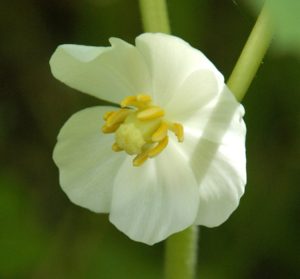Podophyllum is a plant. The root and underground stem (rhizome) are used to make medicine.
Contents
Uses
Podophyllum is highly poisonous when taken by mouth. Nevertheless, some people take it orally for yellowed skin (jaundice), liver ailments, fever, syphilis, hearing loss, and cancer. Podophyllum is also used to empty the bowels, kill parasitic worms in the intestine, and counteract snakebite. Some women take it to cause an abortion.
Podophyllum has been used as a laxative. (It was an ingredient in Carter’s Little LiverPills.) But it has been removed from the market due to safety concerns.
Podophyllum is applied directly to the skin for removal of warts, including plantar warts and sexually transmitted (venereal) warts. It is also used topically for treating pre-cancerous white patches on the tongue and mouth (oral hairy leukoplakia).
Intravaginally, podophyllum is used to treat gynecologic infections.
Benefits
Antibilious, cathartic, hydragogue, purgative.
Podophyllum is a medicine of most extensive service; its greatest power lies in its action upon the liver and bowels. It is a gastro-intestinal irritant, a powerful hepatic and intestinal stimulant. In congested states of the liver, it is employed with the greatest benefit, and for all hepatic complaints it is eminently suitable, and the beneficial results can hardly be exaggerated.
In large doses it produces nausea and vomiting, and even inflammation of the stomach and intestines, which has been known to prove fatal. In moderate doses, it is a drastic purgative with some cholagogue action. Like many other hepatic stimulants, it does not increase the secretion of bile so much when it acts as a purgative.
Podophyllum is a powerful medicine exercising an influence on every part of the system, stimulating the glands to healthy action. It is highly valuable in dropsy, biliousness, dyspepsia, liver and other disorders. Its most beneficial action is obtained by the use of small doses frequently given. In such circumstances, it acts admirably upon all the secretions, removing obstructions, and producing a healthy condition of all the organs in the system. In still smaller doses, it is a valuable remedy in skin diseases.
It may either be given in infusion, decoction, tincture or substance, but it is not to be given warm.
It is often employed in combination with other purgatives, such as colocynth, aloes or rhubarb, and also administered in pills, with extract of henbane or belladonna, to prevent griping.
Externally applied the resin, of podophyllum acts as an irritant. If incautiously handled, it often produces conjunctivitis, and in America it has on this account, when dissolved in alcohol, been used as a counterirritant.
Cautions
No side effects are known.
Interactions
None are recorded.
Other names
Mayapple, Indian apple, Wild mandrake, Pomme de mai, Podophylle pelt, Berberidaceae (Barberry Family)
References
Source: Botanical, https://www.botanical.com/botanical/mgmh/m/maname11.html
WildFlower, http://www.wildflower.org/plants/result.php?id_plant=POPE

